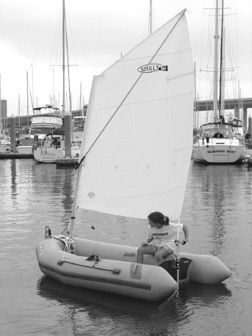
Sailors, by inclination, tend to be inventive. If there’s a problem to be resolved, we often address it by whatever means available—an approach we all know as jury rigging. If you were to happen upon the Scully Rig and Propulsion Rudder on the open water, your first impression might be that this rig was cobbled up out of necessity, but that’s not the case.
Jeff Jelten, a former liveaboard, hatched the idea for his novel products while trying to entice his wife and child into the sport. Neither liked sailing the family’s El Toro when the wind was light, so Jelten conceived the Propulsion Rudder ($299), which he describes as “a fin-like appendage extending from the trialing edge of the rudder blade,” to satisfy them. The intent is to magnify the sculling power of the rudder using a hard, flexible plastic that works like a swim fin.
Jelten felt that one logical application for this device was inflatable boats because of their erstwhile reputation as poor rowing vessels. Then, while using the Propulsion Rudder aboard an inflatable, the thought came to him: “Why not add a sail to this program?” Hence, the Scully Rig, which is available with two sail sizes ($849 or $899).
We tested both products recently and came away with mixed reactions. The multiple parts of the Scully Rig are well-made, assemble with relative ease, fit most small inflatables, but require at least 25 minutes to put together. You won’t get superb performance—the bow-hung daggerboard takes some getting used to—but it might be nice for exploring an anchorage if you’ve lots of time.
We sculled our 9-foot test boat easily with the Propulsion Rudder, though steering requires learning some technique. What’s the downside? You can’t maneuver as well as you can with oars.
Contact – Grin Designs, LLC, 541/758-0794, www.scully-fin.com.







































